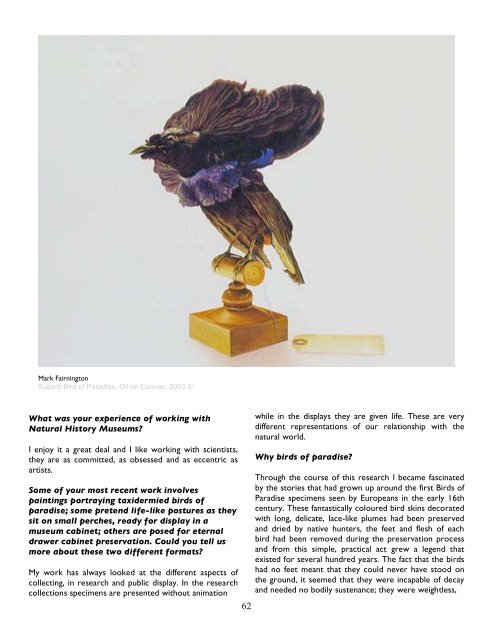RogueTaxidermy - Antennae The Journal of Nature in Visual Culture
RogueTaxidermy - Antennae The Journal of Nature in Visual Culture
RogueTaxidermy - Antennae The Journal of Nature in Visual Culture
Create successful ePaper yourself
Turn your PDF publications into a flip-book with our unique Google optimized e-Paper software.
Mark Fairn<strong>in</strong>gton<br />
Superb Bird <strong>of</strong> Paradise, Oil on Canvas, 2003 <br />
What was your experience <strong>of</strong> work<strong>in</strong>g with<br />
Natural History Museums?<br />
I enjoy it a great deal and I like work<strong>in</strong>g with scientists,<br />
they are as committed, as obsessed and as eccentric as<br />
artists.<br />
Some <strong>of</strong> your most recent work <strong>in</strong>volves<br />
pa<strong>in</strong>t<strong>in</strong>gs portray<strong>in</strong>g taxidermied birds <strong>of</strong><br />
paradise; some pretend life-like postures as they<br />
sit on small perches, ready for display <strong>in</strong> a<br />
museum cab<strong>in</strong>et; others are posed for eternal<br />
drawer cab<strong>in</strong>et preservation. Could you tell us<br />
more about these two different formats?<br />
My work has always looked at the different aspects <strong>of</strong><br />
collect<strong>in</strong>g, <strong>in</strong> research and public display. In the research<br />
collections specimens are presented without animation<br />
62<br />
while <strong>in</strong> the displays they are given life. <strong>The</strong>se are very<br />
different representations <strong>of</strong> our relationship with the<br />
natural world.<br />
Why birds <strong>of</strong> paradise?<br />
Through the course <strong>of</strong> this research I became fasc<strong>in</strong>ated<br />
by the stories that had grown up around the first Birds <strong>of</strong><br />
Paradise specimens seen by Europeans <strong>in</strong> the early 16th<br />
century. <strong>The</strong>se fantastically coloured bird sk<strong>in</strong>s decorated<br />
with long, delicate, lace-like plumes had been preserved<br />
and dried by native hunters, the feet and flesh <strong>of</strong> each<br />
bird had been removed dur<strong>in</strong>g the preservation process<br />
and from this simple, practical act grew a legend that<br />
existed for several hundred years. <strong>The</strong> fact that the birds<br />
had no feet meant that they could never have stood on<br />
the ground, it seemed that they were <strong>in</strong>capable <strong>of</strong> decay<br />
and needed no bodily sustenance; they were weightless,












